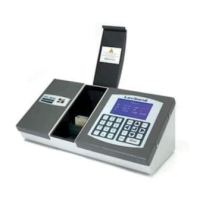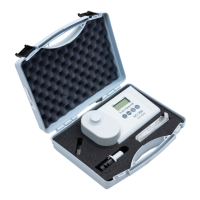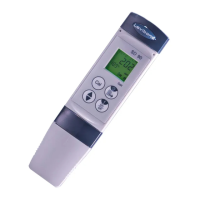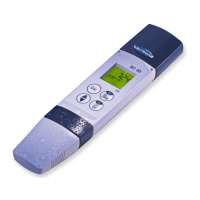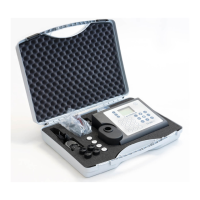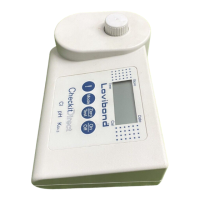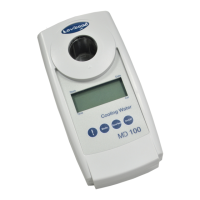16 ISSUE NO. V1.3 DATE 12/12/00
16
Calibrated glass filter sets
For quick and simple calibration checks, sets of graded glass filters, representing a spread of values from the main colour scales
included on the instruments, are available. Single filters for beta carotene and Chlorophyll A measurements are also available. The
typical nominal values for each filter in the set are shown below; individual values may vary but these are always specified on the
certificate of conformity supplied with the filters.
Nominal Colour Values
Code Filter Set No Filters Red Yellow Blue Neutral Measurement Tolerance
13 95 90 Lovibond Red Yellow Neutral 10 0.1 0.5
± 0.1R, ± 0.1Y, ± 0.1N
0.5 1.3 0.1
± 0.1R, ± 0.2Y, ± 0.1N
1.0 2.6 0.1
± 0.1R, ± 0.2Y, ± 0.1N
1.3 3.3 0.5
± 0.1R, ± 0.3Y, ± 0.1N
2.0 5.7 0.1
± 0.2R, ± 0.3Y, ± 0.1N
2.5 8.6 0.1
± 0.2R, ± 0.8Y, ± 0.1N
3.2 15.0 0.1
± 0.3R, ± 1.0Y, ± 0.2N
4.0 22.0 0.1
± 0.4R, ± 2.0Y, ± 0.2N
5.0 34.0 0.1
± 0.5R, ± 3.0Y, ± 0.2N
7.1 51.0 0.5
± 0.7R, ± 5.0Y, ± 0.2N
13 96 10 Lovibond Red Yellow Neutral 5 0.1 0.5
± 0.1R, ± 0.1Y, ± 0.1N
1.0 2.6 0.1
± 0.1R, ± 0.2Y, ± 0.1N
2.0 5.7 0.1
± 0.2R, ± 0.5Y, ± 0.1N
3.2 15.0 0.1
± 0.3R, ± 1.0Y, ± 0.2N
5.0 34.0 0.1
± 0.5R, ± 3.0Y, ± 0.2N
13 96 20 Lovibond Red Yellow Blue 5 1.0 0.5
± 0.1R, ± 0.1B
1.2 4.3 1.2
± 0.2R, ± 0.4Y, ± 0.2B
2.6 11.5 2.1
± 0.2R, ± 2.0Y, ± 0.2B
3.4 15.9 2.9
± 0.3R, ± 2.0Y, ± 0.3B
1.3 0.8
± 0.1R, ± 0.2B
13 69 00 AOCS-Tintometer Colour 3 0.5 1.0
± 0.2R, ± 0.2Y
3.7 13.0
± 0.2R, ± 1.0Y
6.6 50.0
± 0.2R, ± 5.0Y
Code Filter Set No Filters Nominal Colour Values Measurement Tolerance
13 95 10 ASTM Colour 3 0.5, 3.5, 5.0
± 0.1
13 95 60 Gardner Colour 4 2, 8, 12, 17
± 0.1
13 97 00 FAC 5 7, 13, 15, 29, 39
± 0.1
13 76 60 IP Units 4 0.75, 1.25, 2.0, 3.5
± 0.25 (± 0.5 for 3.5)
13 95 70 Platinum-Cobalt/Hazen/APHA 5 5, 20, 50, 100, 300
±
2, ± 2, ± 3, ± 4, ± 10
13 95 80 Saybolt Colour 5 -8, 0, +10, +18, +25
± 1
13 95 20 Beta carotene 1 45 ppm (at 10 mm path length)
± 2ppm
13 95 30 Chlorophyll A 1 0.19 ppm (at 10 mm path length)
± 0.1ppm
If necessary, single calibrated glass filters can be supplied; however, we recommend that complete sets of filters be purchased as the
user can then check more than one point across the colour scale.
11. Factors Influencing Inter-Instrument Differences in Lovibond Colour Measurements
A common query relates to inconsistencies in the Lovibond Colour values obtained for an individual sample when using different
instruments (for example, an automatic Tintometer such as the PFX995 and a visual instrument such as the Model E or F, or two
different visual instruments). There are many reasons why such inconsistencies can arise; we have attempted to provide below a
detailed list of the main factors, which influence inter-instrument differences, which should help you to resolve these queries. These
factors fall into four main categories:
• Poor maintenance of a visual instrument
• Comparison of different instrument versions
• Incorrect use of visual instruments
• Limitations and errors associated with automatic measurement
Poor Maintenance of a Visual Instrument
The Lovibond Tintometer is a precision optical instrument and any discoloration of the white surfaces or dirt on the various optical
components will affect the nature and balance of illumination within the instrument and result in false readings. As a result, for
consistency and accuracy in colour measurement, the Tintometer should be kept as clean as possible and the whiteness of the sample
chamber and the white reference maintained. Particular attention should be given to the following areas:
• Dirt and grease on the glass filters and racks
. These can be cleaned with a soft cloth or washed gently with warm soapy water.
• Dust and dirt which gathers in the optical viewing system and can settle on the lens and correction filter
. If dirty the optical
viewing system can be dismantled and the components cleaned with a suitable soft cloth. Be sure to reassemble correctly (see
manual).
• Discoloration of the white reference
. Periodic replacement is necessary to maintain accuracy of measurement.
• Light source discoloration
. In the Tintometer Model E and earlier models the tungsten bulbs will discolour with age so that the
instrument’s illumination is no longer standardised. As a result, the bulbs should be changed periodically.
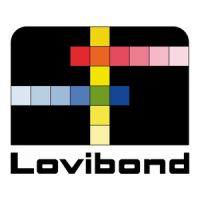
